Echoes of Pausanias: Temple of Apollo Daphnephoros, Eretria (Evvia, Greece)
Let’s take a look at the Temple of Apollo Daphnephoros in ancient Eretria on the island of Evvia (Euboea), Greece.
Eretria, Evvia (Euboea), Greece
You may remember from last fall: Eretria was an important ancient Greek city, particularly in the 6th and 5th centuries BCE. One of the most significant sites in the centre of the old town is the Temple of Apollo Daphnephoros - the laurel bearer.
Temple of Apollo Daphnephoros
The site has multiple temple layers: 1) Geometric period, 2) early Archaic, 3) late Archaic and 4) post-490 BCE. The first excavations were by Κ. Kourouniotis (1899-1910 , with further work by I. Konstantinou (1952-56) and the Swiss Archaeological School (1954 to date). Much of the excavation work was later backfilled; only the foundations of the late Archaic temple and a few remains of the Geometric temples are visible today.

Geometric Temple(s)
The oldest temple layer dates to the Geometric period (c. 800 BCE). One temple was an apsidal hekatompedon (a long, rectangular building over 100 feet long with a rounded end) - the earliest of its type mentioned by Homer. To the south of it was another apsidal building, the Daphnephoron (space with laurels), the oldest building found in Eretria. Clay bases for laurel tree trunks supporting the roof were found at the centre of this building, suggesting it may have imitated the early form of temple to Apollo at Delphi, a hut of laurel branches. At this time, the temple site was likely close to the harbour, as the water would have reached to the agora, just to the south; the shoreline later moved further out due to alluvial deposits.
Dating to the same period are some Geometric pottery fragments, made in a local workshop.

This layer also evidences contact with areas to the east. In particular, several bronze horse blinkers from northern Syria, dating to 9th century BCE, were found. They depict the “Master of the Animals” - a male figure holding two animals - a widespread image in various ancient near eastern cultures. One of these, in the National Archaeological Museum in Athens, bears an Aramaic inscription with the name of King Hazael of Aram-Damascus (842-796 BCE), dedicating it in the Temple of Apollo Daphnephoros.

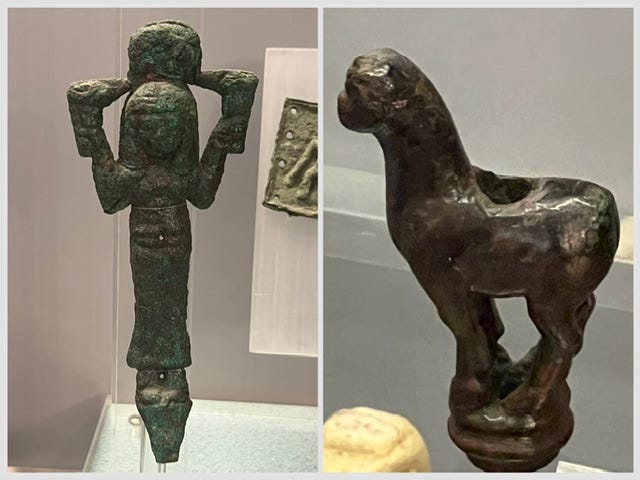
Early Archaic Temple
Next came an early archaic temple - a second hekatompedon temple built at the beginning of the 6th cent. BCE (c. 670-650 BCE) on top of the earlier temple, which was covered with earth to create a strong artificial terrace. It was longer than the first, with six wooden columns on the ends and nineteen down each side, and again had a wide apse at the northwestern end.
Late Archaic Temple
The most renowned of the temples at the site was late archaic, once again built on top of the prior temple, which was again covered with earth. Construction began c. 520-490 BCE and it may have been still unfinished when the Persians razed the city and burned the temple in 490 BCE. A Doric peristyle temple (surrounded by colonnades), with 6 x 14 columns, it had a prodomos (anteroom) and an opisthodomos (back section) with two columns at each end; the cella was divided into three aisles by two rows of columns.
Western Temple Pediment
The only parts of the temple sculptures that have survived are pieces of the west pediment with a relief of the Amazonomachy - the battle of the Greeks against the Amazons. These have been attributed to the great Athenian sculptor Antenor (active c. 530-480 BCE).
In the centre is Athena, with a large Medusa at the centre of her aegis and snakes around the edges. To the right of Athena is the abduction of Antiope, Queen of the Amazons, by Theseus. Theseus is shown mounting a harnessed chariot, of which only part of a horse remains. Antiope wears a leather cuirass and a chiton. The presence on the pediment of Athena and Theseus, the mythical founder of Athenian democracy, underlines the close political ties between the Eretrians and the Athenians at the time.

To the left of Athena was a second chariot, perhaps carrying Hercules. The rest of the scene likely depicted fighting and wounded Amazons and Greek warriors, fragments of which have survived. The east pediment likely featured the Gigantomachy (battle of the Olympian gods against the giants).
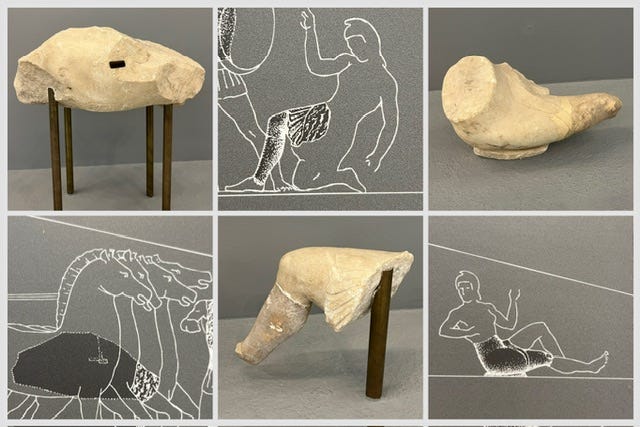
It would have been a sculptural masterpiece, marking a turning point in the history of ancient Greek sculpture, with typical Archaic faces but figures and treatment of perspective previewing the transition from Archaic art to the "severe style" of the Classical period. The hair and garments reflect a decorative trend, with tight coils of hair and many folds and pleats in the drapery.
The sculptures would have been brightly coloured. Antiope's cuirass shows traces of coloured meander and star patterns, while traces of a coloured feather design on Athena's aegis are visible. The holes on the aegis on and around the Medusa and along the edges indicate that various attachments were originally present - some may have been marble pieces carved separately, as would have been the case for Athena's right arm, where a large hole shows where the rest of the arm would have been attached; others may have been metal attachments.
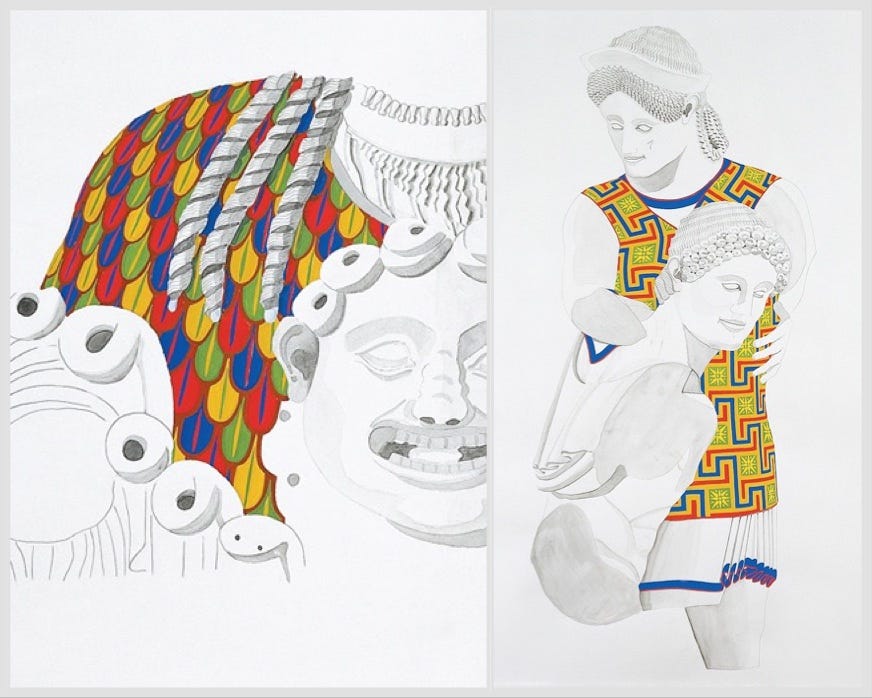
Post-490 BCE Partial Restoration
The late archaic temple was likely not completely destroyed in 490 BCE, but repaired and continued in use, as inscriptions indicate that the site remained a cult center in the 4th and 3rd centuries BCE. In 198 BCE, it was largely destroyed again, this time by the Romans, after which it was gradually abandoned and fell into complete ruin in the first century BCE. The temple was heavily quarried in the Roman period; like the other important sanctuaries in Eretria, much of the temple's architectural elements were reused as building material - only a few column drums, fragments of capitals and triglyphs remain from the building's structure.
Some fragmented sculptures, thought to be from the post-490 BCE repaired temple (an Amazon, a warrior and a torso of Athena), may have been taken to Rome, possibly reused to decorate the temple of Apollo Sosianus.
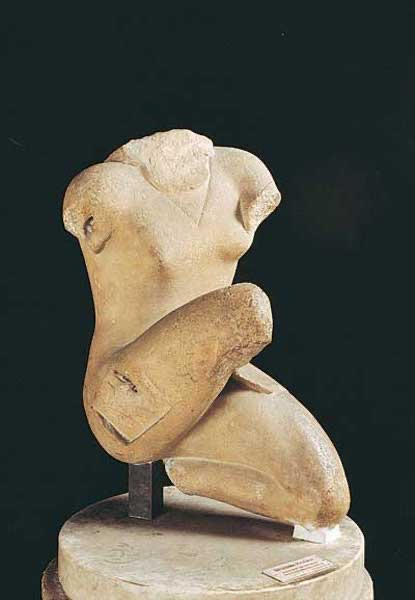
Northeast Sacrificial Area
A nearby deposit identified as a sacrificial area to the north/northeast of the Apollo temple layers is currently thought to have related to the goddess Artemis.
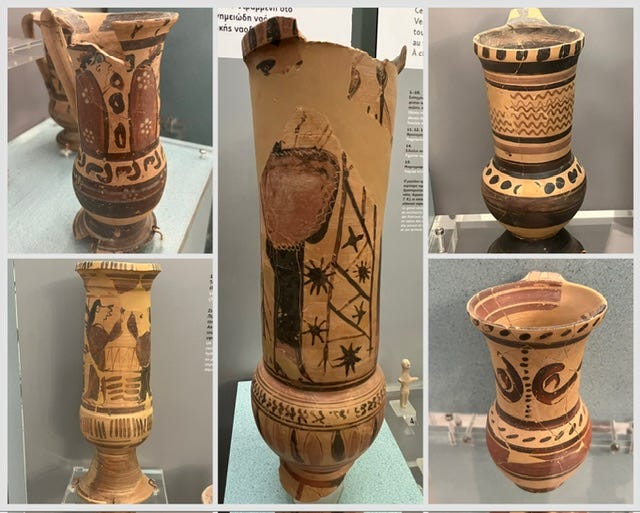
A piece of a stele found at the temple site also confirms the joint worship of Apollo and Artemis there.
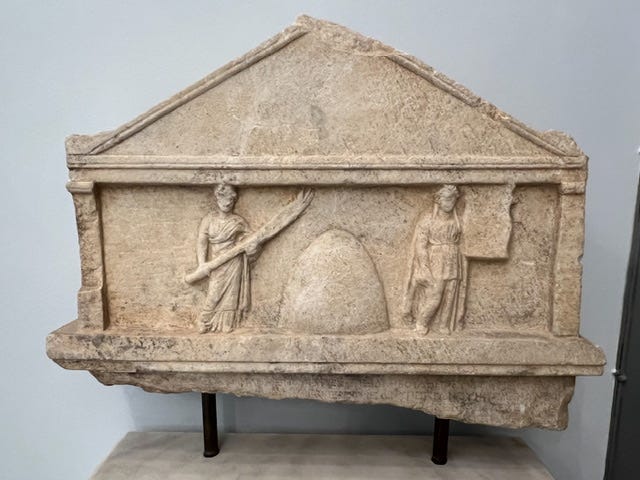
Sources: Materials from Archaeological Museum of Eretria; Efi Sapouna Sakellaraki, Eretria: Site and Museum (2nd Ed., Archaeological Receipts Fund, 2000); Samuel VERDAN, Le Sanctuaire d’Apollon Daphnéphoros à l’époque géométrique (ERETRIA XXII, Fouilles et recherches; Gollion 2013); Sandrine Huber, L’Aire sacrificielle au nord du Sanctuaire d’Apollon Daphnéphoros (Un rituel des époques géométrique et archaïque, vol. 1; Gollion 2003); Temple of Apollo Daphnephoros description on Odysseus.culture.gr; Eretria, Temple of Apollo Daphnephoros (Building), Tufts Perseus Catalog.
There are several related posts on Instagram, which you can check out here: Instagram. And if you liked this post, I’d be grateful if you would share it with others.

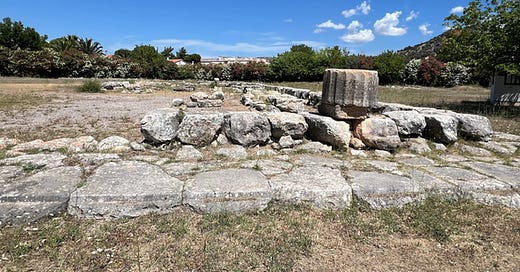



Sandra- What always fascinates me in ancient buildings is the layering of geometric shapes over time. This temple is not exempt from this time-lapsing reality. I love it.
Lovely to see attempts at the colorization of the images. Thanks for sharing!